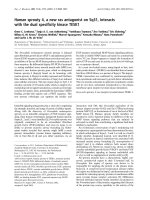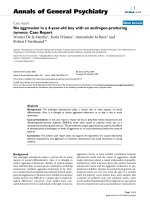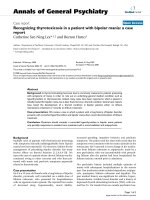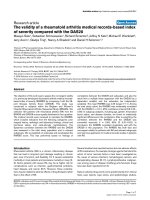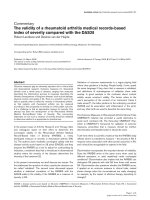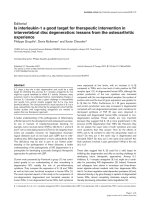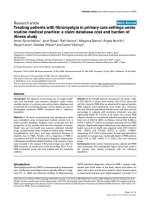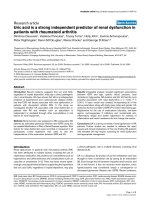Báo cáo y học: " Initial experience with a synthetic sealant PleuraSeal™ after pulmonary resections: a prospective study with retrospective case matched controls" docx
Bạn đang xem bản rút gọn của tài liệu. Xem và tải ngay bản đầy đủ của tài liệu tại đây (880.64 KB, 9 trang )
Dango et al. Journal of Cardiothoracic Surgery 2010, 5:50
/>Open Access
RESEARCH ARTICLE
© 2010 Dango et al; licensee BioMed Central Ltd. This is an Open Access article distributed under the terms of the Creative Commons
Attribution License ( which permits unrestricted use, distribution, and reproduction in
any medium, provided the original work is properly cited.
Research article
Initial experience with a synthetic sealant
PleuraSeal™ after pulmonary resections: a
prospective study with retrospective case matched
controls
Sebastian Dango*
1
, Rong Lin
2
, Ellen Hennings
1
and Bernward Passlick
1
Abstract
The objective of this study was to evaluate postoperative outcome and efficacy of a hydrogel tissue sealant for
prevention of alveolar leakage after open lung resections.
20 consecutive patients were enrolled in the PleuraSeal™ sealant group (PSG) and case matched with 20 retrospective
controls (CG) with standard treatment. Assessment of postoperative air leakage was performed until chest tube
removal. Patients were followed until 30 days after discharge.
At end of surgery, 100% in the PSG and 0% in the CG were air leak free (p < 0.001). Duration of postoperative chest tube
suction was shorter in PSG (p < 0.001), and air leak chest tube was removed earlier (p = 0.03). Limitation for chest tube
removal due to a pulmonary leak was 35% in CG and 5% in PSG (p = 0.04). Patients remaining air leak free thru
discharge was 95% and 15% for PSG and CG (p < 0.001).
The study demonstrated a superior efficacy of PleuraSeal™ sealant compared with standard surgical treatment for
sustained sealing of postoperative air leakage and causes shorter air leak chest tube duration.
Introduction
Postoperative air leakage remains the most common pul-
monary complication in patients undergoing pulmonary
resection with a reported occurrence of 18-58% of the
cases [1,2]. Persistent postoperative air leakage (>7 days)
has been reported in up to 25% of patients undergoing
pulmonary resection [3]. Described risk factors for pul-
monary leakage are incomplete fissures [4], underlying
lung diseases such as emphysema, fibrosis, tuberculosis
or malignancies [5], presence of a lymphangioleiomyo-
matosis [5], intrathoracic adhesions [6], older patients
(>75 years) [7], and lower diffusion capacity [8]. Deleteri-
ous effects of prolonged air leaks are longer chest tube
duration often associated with prolonged pain [6,9], pro-
longed hospitalization [6,8,10] and greater health care
costs [9,10], increased risk of pneumonia and empyema
[8,9], decreased postoperative mobility [11], and can
necessitate pleurodesis or re-operation [11]. In addition,
the incidence of postoperative empyema increases dra-
matically when air leak is present. As shown by Brunelli
et al [12], postoperative empyema was found in 1% and
10% of patients with pulmonary leaks less than and
greater than 7 days, respectively.
Surgical suturing and stapling are the standard meth-
ods for the prevention and treatment of air leakage and
can be challenging especially in patients with fragile lung
tissue or emphysema as seen in smokers. Over the last
decade, various surgical sealants have been introduced
for further prevention and reduction of air leaks. These
include liquid autologous fibrin-based sealants [13,14],
collagen fleece-bound sealants [15,16], and polyethylene
glycol (PEG) hydrogel sealants such as PleuraSeal™
[17,18]. PleuraSeal™ lung sealant is a new, easy to prepare,
100% synthetic, flexible resorbable blue gel that expands
with lung inflation and has a sealing strength five-times
greater than normal liquid fibrin glue [19]. PleuraSeal™
sealant begins as two liquids that crosslink when mixed;
rapidly changing within seconds into a solid hydrogel that
mechanically bonds to the underlying tissue. This hydro-
* Correspondence:
1
Department of Thoracic Surgery, University Medical Centre Freiburg, 79106
Freiburg, Germany
Full list of author information is available at the end of the article
Dango et al. Journal of Cardiothoracic Surgery 2010, 5:50
/>Page 2 of 9
gel remains in place while natural healing occurs under-
neath the gel, hydrolyzing like absorbable sutures within
4-8 weeks. The objectives of this study were to evaluate
the postoperative outcome, safety, and efficacy of this
new hydrogel tissue sealant for the sealing of alveolar
leakage after lung resections.
Patients and Methods
Setting and samples
To investigate the efficacy and postoperative outcome,
PleuraSeal™ lung sealant system was prospectively evalu-
ated as an adjunct to standard closure techniques for con-
trol of visceral pleural air leaks in patients scheduled for
pulmonary resection. These data were compared with an
individually case matched retrospective control cohort.
Sample size calculation was based on a superiority test
for two proportions using Fisher's Exact Test, estimated
proportion was 72% for PSG and 15% for CG, respec-
tively. Therefore, for an estimated power of 90% a sample
size of 18 patients for each group was necessary to show a
difference in the two-sided test for the primary endpoints
to reach statistical significance. Data were collected at the
University Hospital Freiburg, Department of Thoracic
Surgery, from patient admission to discharge. Twenty
consecutive patients with anatomical resection were
included. Inclusion criteria for both groups were patient
age 18 years or older, and a scheduled or completed (in
retrospective control group) lobectomy or segmental
wedge resection via an open thoracotomy approach and
presence of an initial intraoperative air leak after resec-
tion. Preoperatively, groups were well balanced regarding
concomitant pulmonary disease, mean FEV1, lung tissue
quality, presence of diabetes and smoking habit. The
study was approved by the local ethical committee (340/
08, 12/02/08) and written informed consent of all patients
was obtained. Only patients with intraoperative air leaks
grade 1-2 based on the Macchiarini scale [20] after stan-
dard surgical suture or stapling were enrolled. All sub-
jects had two chest tubes during the first 48 hours after
thoracotomy. Routinely two silicone chest tubes (ventral
21 Ch and dorsal 24 Ch, silicone chest tubes, Redax Com-
pany, Mirandola, Italy) were placed after thoracotomy
and connected to a water sealed drainage system. Suction
of -20 cm H
2
O was taken off once no air leaks were
detected after 12 hours of observation time. The ventral
chest tube (air leak chest tube) was taken out when there
was no evidence of an air leak within the last 24 hours,
and the dorsal tube was taken out when less than 200 ml
drainage was recorded within last 24 hours. Assessment
of postoperative air leakage was performed twice daily
until chest tube removal and discharge. Patients were dis-
charged and re-evaluated within 30 days after leaving the
hospital, with two fixed scheduled visits to an ambulatory
outpatient clinic. Primary criteria for discharge were no
significant pain (VAS ≤ 2) under present pain medication
and absence of chest tube.
Application and technique of PleuraSeal™ Lung Sealant
System
Prior to the application of PleuraSeal™ lung sealant an
intraoperative air leak test during lung inflation was car-
ried out to evaluate the location and grade of air leaks as
described above. In the event of a grade 3 air leak addi-
tional suture or stapling was performed to downgrade the
pulmonary leak, so that PleuraSeal sealant was applied
only in patients with grade 1 or 2 leaks. PleuraSeal™ poly-
mer kit with a total volume of 5 ml was applied using a
MicroMyst™ Applicator with a continuous flow (flow reg-
ulator) under aseptic conditions to seal intraoperative air
leaks as well as prophylacticly on staple lines and other
manipulated lung tissue. The lung surface was as dry as
possible and the lung was inflated between 50-75% of its
maximal volume. The product was uniformly distributed
in a layer of 1-2 mm thickness, and on areas of extending
pulmonary lesions a thicker layer was achieved of up to 3
mm. Excessive material was mechanically removed using
suction or blunt dissection. Contraindications to apply
PleuraSeal™ lung sealant include uncontrolled transected
bronchioles >1 mm, and intrathorax infections. Addition-
ally, the sealant was not applied to bronchial stumps or
bronchial anastomoses. Following sealant application
leak sites underwent another water submersion test
under pressure of 25 mmHg. Sealant application could be
repeated if air leakage control was not halted after the
first application.
Clinicopathological Parameters
Concerning overall clinical characteristics, a total of 20
consecutive patients in the PleuraSeal™ sealant study
group were matched with 20 retrospective patients that
underwent pulmonary resection via an anterolateral tho-
racotomy as a control group. Baseline characteristics and
intraoperative findings are shown in Table 1 and 2,
respectively without any statistical difference between the
two groups (Table 1. and 2.).
Efficacy and safety endpoints
Three primary endpoints were defined by protocol:
reduction of intraoperative air leakage, the presence and
duration of postoperative air leak, and postoperative
morbidity. Secondary parameters were duration of chest
tube placement as well as time to discharge. Adverse
events (AE) for the prospectively collected study cohort
from the screening period prior to admission to our sur-
gical ward until follow-up of 30-days after discharge were
documented and reported if eligible. Complications were
defined as occurrence of empyemas, incomplete lung
inflation, pneumothorax, presence of bronchogenic fis-
tula, chylothorax, cardiovascular complications, any
Dango et al. Journal of Cardiothoracic Surgery 2010, 5:50
/>Page 3 of 9
other organ specific failure, severe postoperative pain,
acute esophagitis, and the need for additional procedures
(re-operation, pleurodesis, and replacement of chest
tube).
Statistical analyses
All statistical analyses were performed using SAS
®
Version
9.1. All statistical tests were two-sided at the 5% signifi-
cance level. Continuous variables were summarized using
mean and standard deviation, and the two sample t-test
was used to test the difference between treatment groups.
Categorical variables were summarized by frequencies
and percentages, and the proportions were calculated and
compared between treatment groups using Fisher's Exact
test.
Table 1: Baseline characteristics and pre-operative variables
Variable
a
Overall PleuraSeal™ Group Control Group
p-value
b
40 20 20
Age (yrs.), mean (SD) 69 (45-82) 66 (47-81) 0.34
Gender
Male 31 (77%) 14 (70%) 17 (85%)
Female 9 (22%) 6 (30%) 3 (15%) 0.45
Chronic lung disease 22 11 11
COPD 19 (47%) 9 (45%) 10 (50%)
Lung emphysema 2 (5%) 2 (10%) 0 (0%)
Asthma 1 (2%) 0 (0%) 1 (5%) 0.58
Pulmonary function
c
FEV1 actual (Ø %), mean (SD) 85.5 (17.9) 87 (20.2) 84 (15.6) 0.51
FEV1 predicted (Ø %), mean (SD) 65.5 (16.2) 69 (17.6) 62 (14.8) 0.18
DLCO actual (Ø %), mean (SD) 70.5 (14.5) 70 (15.7) 71 (13.3) 0.84
DLCO predicted (Ø %), mean (SD) 55 (14.6) 56 (16.3) 54 (12.9) 0.55
Neoadjuvant therapy 1 0 1
Radiation 0 (0%) - - NA
Chemotherapy 1 (2%) 0 (0%) 1 (5%) 1.00
Concomitant disease 23 14 9
Diabetes 7 (17%) 4 (20%) 3 (15%) 1.00
Others
d
16 (40%) 10 (50%) 6 (30%) 0.23
Smoking behaviour
Current Smoker 15 (37%) 8 (40%) 7 (35%)
Ex smoker (≥12 month) 13 (32%) 6 (30%) 7 (35%)
Never smoked 12 (30%) 6 (30%) 6 (30%) 0.14
a
Numbers in percentage were rounded up were indicated.
b
Continuous variables were compared between groups by Students' t-test. Categorical variables were compared using two-sided Fisher's Exact
test
c
Preoperative pulmonary function test and postoperative variables based on amount of lung resection; FEV1: Forced expiratory volume (1 sec);
DLCO: CO volume-adjusted diffusion capacity). Data shown in % of total function and as mean with SD where indicated; SD standard deviation.
d
Other entities: hypertension, cardiac insufficiency, arrhythmia absoluta
Dango et al. Journal of Cardiothoracic Surgery 2010, 5:50
/>Page 4 of 9
Table 2: Surgical variables and intra-operative findings
Variable
a
Overall PleuraSeal™ Group Control Group
p-value
b
40 20 20
Surgical diagnosis
Lung cancer 38 (95%) 18 (90%) 20 (100%)
Lung metastasis 2 (5%) 2 (10%) 0 (0%) 0.48
Operation time (hh:mm) 02:35 03:07 0.07
Lung tissue quality 20 20
Normal 21 (52%) 10 (50%) 11 (55%)
Fragile 19 (47.5%) 10 (50%) 9 (45%) 1.00
Procedure
Right lobectomy 19 (47.5%) 7 (35%) 12 (60%)
Upper 13 (32%) 6 (30%) 7 (35%)
Middle 0 (0%) 0 (0%) 0 (0%)
Lower 6 (15%) 1 (5%) 5 (25%)
Left lobectomy 18 (45%) 11 (55%) 7 (35%)
Upper 10 (25%) 7 (35%) 3 (15%)
Lower 8 (20%) 4 (20%) 4 (20%)
Segmentectomy 2 (5%) 1 (5%) 1 (5%)
Bilobectomy 1 (2.5%) 1 (5%) 0 (0%) 0.26
Intraoperative air leaks characteristics
Intraoperative leak free
(in %)
100% 0% <0.001
Postoperative leak free
(in %)
c
95% 15% <0.001
Initial # of
intraoperative air
leaks/patient (Ø)
d
1.6 1.6 1.6 1.00
Initial grade of air
leaks/patient
1.35 1.3 1.4 0.77
Additional procedure
for air leak control
826
Suture 8 (20%) 2 (10%) 6 (30%) 0.23
Staple 0 (0%) - - NA
a
Numbers in percentage were rounded up were indicated.
b
Continuous variables were compared between groups by Students' t-test. Categorical variables were compared using two-sided Fisher's
Exact test.
c
Leak free at the end of surgery
d
Based on Macchiarini scale
Dango et al. Journal of Cardiothoracic Surgery 2010, 5:50
/>Page 5 of 9
Results
Trial treatment and control group
In the PleuraSeal™ sealant group two patients failed to
have any intraoperative air leaks and were excluded from
the study after screening. Conversely 91% of prospective
lobectomy patients (20/22) demonstrated at least one
intraoperative air leak. The twenty study patients
received primary PleuraSeal™ sealant treatment after a
water submersion test identified air leak location. The
majority of air leaks occurred in the interfissure area
(52%), with 23% at the staple lines, 6% at the suture lines,
6% due to adhesiolysis, and the remaining 13% due to
other tissue manipulation (Table 3). For each patient the
number of air leaks were counted and graded. Prior to the
application of PleuraSeal™ sealant, the grade of air leak
was 1.2 +/- 0.4 (mean +/- SD) in the PSG which was com-
parable to 1.1 +/- 0.2 (mean +/- SD) in CG. (p = 0.24).
Also prior to the application of PleuraSeal™ sealant, the
number of intraoperative air leaks per patient was 1.6 +/-
0.6 (mean +/- SD) in the PSG which was comparable to
1.4 +/- 0.5 (mean +/- SD) in CG (p = 0.39). In both groups
additional suturing was carried out if necessary to down-
grade air leaks prior to PleuraSeal™ sealant application in
the PSG and closure in the CG. This was performed in 2
cases (10%) in the PSG and 6 cases (30%) in the CG with-
out any significant difference between the two groups (p
= 0.23). Neither in the PSG nor CG did we perform any
additional stapling. On average 2.8 ml of PleuraSeal™ seal-
ant was applied in less than one minute to the air leak
sites and prophylacticly to all manipulated tissue. The
MicroMyst™ applicator enabled multiple starts and stops
during application without clogging. Only one patient
needed a second application of PleuraSeal™ sealant. The
mean operating time in the PSG was 2.6 hours which was
comparable to the 3.1 hours in the CG (p = 0.08).
Table 3: Application of PleuraSeal™ sealant
Variable
a
PleuraSeal™ Group Control Group
p-value
b
20 20
Adjusted air leaks
Total # of air leaks 31 28 NA
Initial # of air leaks/patient 1.6 (0.7) 1.6 (0.5) 1.00
# of air leaks/patient after additional treatment 1.6 (0.6) 1.4 (0.5) 0.39
Initial grade of air leaks/patient 1.3 (0.6) 1.4 (0.5) 0.77
Grade of air leaks/patient after additional treatment 1.2 (0.4) 1.1 (0.2) 0.24
PleuraSeal™ application 20 - NA
Volume of sealant (ml)
c
2.8 (1.0) - -
Duration (s)
c
43.0 (17.7) - -
Second application (n) 1 (5%) - -
Micromyst applicator 20 (100%) - -
Air leak locations NA
Staple lines 7 (23%) - -
Suture lines 2 (6%) - -
Interfissure area 16 (52%) - -
Adhesiolysis 2 (6%) - -
Other manipulation 4 (13%) - -
a
Numbers in percentage were rounded up were indicated.
b
Continuous variables were compared between groups by Students' T-test. Categoric variables were assessed by two-tailed Pearson's Chi square
test.
c
Data shown as mean with standard deviation (SD), # number of air leaks.
Dango et al. Journal of Cardiothoracic Surgery 2010, 5:50
/>Page 6 of 9
Postoperative outcome
Overall morbidity was 52.5% and we could not find a sta-
tistical difference between the two study groups (p = 0.60)
(Table 4). In total, 4 (10%) patients in the combined PSG
and CG had severe pain postoperatively defined by a
visual analogue scale (VAS) score ≥4 under present pain
medication, in 5 (12.5%) patients cardiac complications
were observed, and only one patient needed postopera-
tive mechanical ventilation after onset of an adult respira-
tory distress syndrome. We did not experience any
pleural empyema, lung emboli, incomplete lung inflation,
re-thoracotomies, or re-placement of a chest tube in
either of the groups. No patient died during the study
period. All patients were discharged from hospital and
completed the follow up period without any late compli-
cations. Hospital length of stay was 9.9 days in the PSG
vs. 11.7 days in the CG, however, it did not reach statisti-
cal significance (p = 0.178). An interesting observation is
that the shorter hospital length of stay of 1.8 days in the
PSG corresponds exactly to the 1.8 days earlier removal
of the air leak chest tube in the PSG.
Intraoperative and postoperative air leakage and chest
tube duration
At the end of surgery, 100% of the patients treated with
the synthetic PleuraSeal™ sealant and 0% of the control
group were air leak free (p < 0.001). One hour after sur-
gery thru 30 day follow-up, 95% of the patients in the PSG
were still air leak free compared to 15% in the CG (p <
0.001). After admission to our post operative unit all
chest tubes were treated with suction as defined by proto-
col. The duration of postoperative air leak chest tube suc-
Table 4: Post-operative complications and outcome
Variable
a
Overall PleuraSeal™ Group Control Group
p-value
b
40 20 20
Duration of chest tube (d)
c
, mean (SD)
Ventral chest tube removal (air leak) 2.1 (1.2) 3.9 (3.3) 0.03
Dorsal chest tube removal (drainage) 5.1 (4.0) 5.2 (3.4) 0.94
Chest tube on suction (h)
c
mean (SD)
22.9 (1.8) 49.7 (28.2) <0.001
Limiting factor for chest tube removal
Air leakage 8 (20%) 1 (5%) 7 (35%) 0.04
Drainage 32 (80%) 19 (95%) 13 (65%) 0.94
Total # of postoperative complications
d
21 (52.5%) 10 (50%) 11 (55%) 1.000
Bronchogenic fistula 1 (2.5%) 0 (0%) 1 (5%)
Chylothorax 3 (7.5%) 2 (10%) 1 (5%)
Pneumonia 6 (15%) 4 (20%) 2 (10%)
Mechanical Ventilation/ARDS 1 (2.5%) 0 (0%) 1 (5%)
Tachyarrhythmia absoluta 5 (12.5%) 3 (15%) 2 (10%)
Postoperative severe pain 4 (10%) 1 (5%) 3 (15%)
Others
e
1 (2.5%) 0 (0%) 1 (5%)
Length of stay(days)
c
Potential hospitalization 8.2 (4.6) 10.3 (5.5) 0.205
Actual hospitalization 9.9 (3.7) 11.7 (4.4) 0.178
a
Numbers in percentage were rounded up were indicated.
b
Continuous variables were compared between groups by Students' T-test. Categoric variables were assessed by two-tailed Pearson's Chi square
test.
c
Data shown as mean with standard deviation (SD)
d
# total number of events
e
Other complications: acute esophagitis.
Dango et al. Journal of Cardiothoracic Surgery 2010, 5:50
/>Page 7 of 9
tion was significantly shorter in the PSG compared to the
CG (Figure 1, p < 0.001), and air leak chest tube (ventral
chest tube) was removed significantly earlier at 2.1 days
for PSG compared to 3.9 days for CG (Figure 2, p = 0.03).
Limitation of chest tube removal due to a pulmonary leak
was 5% in PSG and 35% in CG (p = 0.04) without any dif-
ference for drainage time (p = 0.94). All patients in the
PSG had no evidence of pneumothorax in chest X-ray
before discharge and after a 30 day follow-up period com-
pared with 4 (20%) in the CG (p = 0.16).
Conclusion
A simple, quick, and reproducible method to seal air
leaks during thoracic procedures for lung resections
could have a great impact on postoperative air leakage
and clinical outcome. Ideally, such a product should bind
rapidly to the tissue with strong adherence and not con-
strict lung volume expansion. It should be bacteriostatic
and non-irritating, slowly and controllably break down in
body fluids and be systemically non-toxic and inherently
safe [9,21]. The trial sealant PleuraSeal™ used in the study
has been shown to have very good biocompatibility and
has undergone extensive pre-clinical testing both in vitro
[19], and in vivo [21] Furthermore, its components have
been used in several medical applications [22,23] and it
has been proven to have strong adherence and flexibility
in an ex-vivo porcine lung model, sealing coin size defects
measuring approximately 5 mm in depth and 15 mm in
diameter and with lung expansion up to 40 cm H2O. In
this model, the trial sealant demonstrated 100% adher-
ence and expansion without sealant tearing or delamina-
tion, and without restricting the normal expansion of the
lung. The average burst strength pressure for the Pleu-
raSeal™ sealant applied with the MicroMyst™ air-assisted
applicator over the coin size defects was 291 cm H2O,
167 cm H2O, and 156 cm H2O at 0, 24, and 48 hours,
respectively, which exceeds the maximal cough pressure
at 2 days post-op of 102 cm H2O [24]. The mode of fail-
ure in all instances was cohesive rather than adhesive.
The study demonstrated a superior efficacy of the trial
sealant as compared with standard surgical treatment for
sustained sealing of postoperative air leakage following
pulmonary resections. It enables an immediate and safe
air tight seal intraoperatively with a high proportion of
patients remaining air leak free, shorter air leak chest
tube suction and duration, and may lead to a decrease in
hospital length of stay. However, many factors can impact
the length of stay for thoracic patients: postoperative air
leaks, co-morbidities, the patient's social environment
and healthcare reimbursement incentives. It should be
noted that under the German Healthcare System there is
currently no financial incentive to discharge patients
from the hospital as soon as possible, as there is in the US
system. One plausible explanation for the tendancy of
shortened hospital length of stay in this study is that the
earlier removal of the air leak chest tube and attached
canister in the PSG increased patient mobility leading to
a faster recovery. It is interesting that a shorter hospital
length of stay of 1.8 days in the PSG corresponds exactly
to the 1.8 days earlier removal of the air leak chest tube in
the PSG.
However, the study has its limitations as far as the
included study population is concerned. Since this is a
preliminary study after introduction of this surgical
device in patients undergoing lung resections only a small
number of 20 patients as calculated above were included
and compared to a case-match control cohort. Of note is
that we could demonstrate statistical significance of p <
0.001 for our primary outcomes and showed reduced
intraoperative air leakage and postoperative leak free
through discharge.
The ease of use and effective sealing attributes of the
PleuraSeal™ sealant enables a surgeon to change their
mindset toward alveolar air leaks, and strive toward
Figure 1 Time of chest tube suction.
Figure 2 Duration of postoperative chest tube drainage for air
leakages.
Dango et al. Journal of Cardiothoracic Surgery 2010, 5:50
/>Page 8 of 9
intra-operative leak free surgery. It is common practice to
fill the chest cavity with warm saline to check intraopera-
tively for bronchopleural fistula and during this step one
may also accurately identify the location of alveolar air
leaks by gradually lowering the water level and identify-
ing the source of air bubbles. The sealant may then be
applied site specifically to cover all the identified air leaks
and also prophylacticly to staple lines and manipulated
tissue in less than one minute. Especially, since 52% of the
intra-operative air leaks in the study were detected in the
interfissure area which is difficult to access by standard
suturing or fleece-bond sealants, PleuraSeal™ as a liquid
sealant is ideal to seal air leaks in this interlobar space
with its many anatomical variations. As part of this Pro-
tocol we resubmerged the lung parenchyma with warm
saline and retested under pressure to confirm that all
alveolar air leaks had been successfully halted with the
study sealant, and in only one patient was an additional
application of the trial sealant required to obtain intra-
operative leak free surgery. We did not experience any
pleural empyema, pneumothoraces, chest tube replace-
ment, or re-operation in the presented study.
In summary, this liquid, hydrogel tissue sealant is safe
and easy to use and has a significant impact on intra- and
postoperative air leakage prevention as well as on early
chest tube removal for air leaks. We also found a trend
toward a reduced length of hospitalization, but this did
not reach statistical significance.
Competing interests
The authors declare that they have no competing interests.
Authors' contributions
SD participated in the study design, collected patient samples and performed
data acquisition, analysed the data, drafted the manuscripts, and is the corre-
sponding author. RL carried out statistical analysis. EH collected patient sam-
ples and carried out data acquisition. BP reviewed the study design and
manuscript draft. All authors have read and approved the final manuscript.
Acknowledgements
This study was funded by Covidien Surgical Devices. The authors are grateful to
John Hauschild for his assistance in compiling the data for analysis and review-
ing the manuscript.
Author Details
1
Department of Thoracic Surgery, University Medical Centre Freiburg, 79106
Freiburg, Germany and
2
Biostatistical Consulting Inc., 10 Mall Road, Suite 200,
Burlington, MA 01803, USA
References
1. Ciccone AM, Meyers BF, Guthrie TJ, et al.: Long-term outcome of bilateral
lung volume reduction in 250 consecutive patients with emphysema.
J Thorac Cardiovasc Surg 2003, 125:513-525.
2. Okereke I, Murthy SC, Alster JM, Blackstone EH, Rice TW: Characterization
and importance of air leak after lobectomy. Ann Thorac Surg 2005,
79:1167-1173.
3. Serra-Mitjans M, Belda-Sanchis J, Rami-Porta R: Surgical sealant for
preventing air leaks after pulmonary resections in patients with lung
cancer. Cochrane Database Syst Rev 2005:CD003051.
4. Gomez-Caro A, Calvo MJ, Lanzas JT, Chau R, Cascales P, Parrilla P: The
approach of fused fissures with fissureless technique decreases the
incidence of persistent air leak after lobectomy. Eur J Cardiothorac Surg
2007, 31:203-208.
5. Passlick B, Born C, Haussinger K, Thetter O: Efficiency of video-assisted
thoracic surgery for primary and secondary spontaneous
pneumothorax. Ann Thorac Surg 1998, 65:324-327.
6. Abolhoda A, Liu D, Brooks A, Burt M: Prolonged air leak following radical
upper lobectomy: an analysis of incidence and possible risk factors.
Chest 1998, 113:1507-1510.
7. Hazelrigg SR, Nunchuck SK, LoCicero J III: Video Assisted Thoracic
Surgery Study Group data. Ann Thorac Surg 1993, 56:1039-1043.
8. DeCamp MM, Blackstone EH, Naunheim KS, et al.: Patient and surgical
factors influencing air leak after lung volume reduction surgery:
lessons learned from the National Emphysema Treatment Trial. Ann
Thorac Surg 2006, 82:197-206.
9. Ranger WR, Halpin D, Sawhney AS, Lyman M, Locicero J: Pneumostasis of
experimental air leaks with a new photopolymerized synthetic tissue
sealant. Am Surg 1997, 63:788-795.
10. Stephan F, Boucheseiche S, Hollande J, et al.: Pulmonary complications
following lung resection: a comprehensive analysis of incidence and
possible risk factors. Chest 2000, 118:1263-1270.
11. Ochroch A, Barnett R: Synthetic Sealants for Preventing Air Leaks after
Pulmonary Resection Official Newsletter of the Society of Cardiovascular
Anesthesiologists; 2002.
12. Brunelli A, Xiume F, Al RM, Salati M, Marasco R, Sabbatini A: Air leaks after
lobectomy increase the risk of empyema but not of cardiopulmonary
complications: a case-matched analysis. Chest 2006, 130:1150-1156.
13. Belboul A, Dernevik L, Aljassim O, Skrbic B, Radberg G, Roberts D: The
effect of autologous fibrin sealant (Vivostat) on morbidity after
pulmonary lobectomy: a prospective randomised, blinded study. Eur J
Cardiothorac Surg 2004, 26:1187-1191.
14. Fabian T, Federico JA, Ponn RB: Fibrin glue in pulmonary resection: a
prospective, randomized, blinded study. Ann Thorac Surg 2003,
75:1587-1592.
15. Anegg U, Lindenmann J, Matzi V, Smolle J, Maier A, Smolle-Juttner F:
Efficiency of fleece-bound sealing (TachoSil) of air leaks in lung
surgery: a prospective randomised trial. Eur J Cardiothorac Surg 2007,
31:198-202.
16. Lang G, Csekeo A, Stamatis G, et al.: Efficacy and safety of topical
application of human fibrinogen/thrombin-coated collagen patch
(TachoComb) for treatment of air leakage after standard lobectomy.
Eur J Cardiothorac Surg 2004, 25:160-166.
17. Porte HL, Jany T, Akkad R, et al.: Randomized controlled trial of a
synthetic sealant for preventing alveolar air leaks after lobectomy. Ann
Thorac Surg 2001, 71:1618-1622.
18. Wain JC, Kaiser LR, Johnstone DW, et al.: Trial of a novel synthetic sealant
in preventing air leaks after lung resection. Ann Thorac Surg 2001,
71:1623-1628.
19. Campbell P: Evaluation of Absorbable Surgical Sealants: In-vitro
Testing. In In-vitro testing Edited by: Bennet S, Sawhney A. Covidien
Laboratories, Mansfield, MA; 2007.
20. Macchiarini P, Wain J, Almy S, Dartevelle P: Experimental and clinical
evaluation of a new synthetic, absorbable sealant to reduce air leaks in
thoracic operations. J Thorac Cardiovasc Surg 1999, 117:751-758.
21. Locicero J: Evaluation of PleuraSeal™ Sealant System as a Thoracic
Sealant in a Canine Lung Resection Model. In North American Science
Associates (NAMSA) Edited by: Campbell P, Muench TR. Northwood, Ohio;
2007.
22. Bennett SL, Melanson DA, Torchiana DF, Wiseman DM, Sawhney AS: Next-
generation hydrogel films as tissue sealants and adhesion barriers. J
Card Surg 2003, 18:494-499.
23. Preul MC, Bichard WD, Spetzler RF: Toward optimal tissue sealants for
neurosurgery: use of a novel hydrogel sealant in a canine durotomy
repair model. Neurosurgery 2003, 53:1189-1198.
Received: 12 March 2010 Accepted: 16 June 2010
Published: 16 June 2010
This article is available fro m: http://www. cardiothoracics urgery.org/con tent/5/1/50© 2010 Dango et al; licensee BioMed Central Ltd. This is an Open Access article distributed under the terms of the Creative Commons Attribution License ( ), which permits unrestricted use, distribution, and reproduction in any medium, provided the original work is properly cited.Journal of Cardiothoracic Surgery 2010, 5:50
Dango et al. Journal of Cardiothoracic Surgery 2010, 5:50
/>Page 9 of 9
24. Byrd RB, Burns JR: Cough dynamics in the post-thoracotomy state.
Chest 1975, 67:654-657.
doi: 10.1186/1749-8090-5-50
Cite this article as: Dango et al., Initial experience with a synthetic sealant
PleuraSeal™ after pulmonary resections: a prospective study with retrospec-
tive case matched controls Journal of Cardiothoracic Surgery 2010, 5:50
